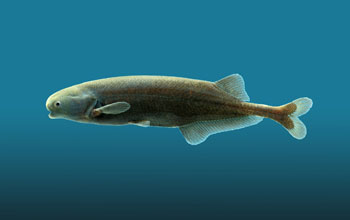Multimedia Gallery
Mechanisms of Signal Diversity in Communication (image 2)
A Brienomyrus brachyistius, commonly known as the black whale. A weakly electric fish native to Africa, B. brachyistius communicate with each other by means of electric discharges in which the waveform, or shape, allow it to recognize fish of the same species, including individual fish.
These fish were the subject of research by Bruce Carlson, Ph.D., an assistant professor of biology at Washington University in St. Louis, Mo., who is studying this African family of weakly electric fish. Carlson found that different species in the mormyrid family communicate using different electric signals, which identifies the different species. When seeking a mate they can find partners of their own kind by listening for their preferred electric dialect. To learn more about Carlson's research, supported by the National Science Foundation, visit his website Here. [See related image Here.]
Credit: Robert Lewis, IT Catalysts, Inc.
See other images like this on your iPhone or iPad download NSF Science Zone on the Apple App Store.
Images and other media in the National Science Foundation Multimedia Gallery are available for use in print and electronic material by NSF employees, members of the media, university staff, teachers and the general public. All media in the gallery are intended for personal, educational and nonprofit/non-commercial use only.
Images credited to the National Science Foundation, a federal agency, are in the public domain. The images were created by employees of the United States Government as part of their official duties or prepared by contractors as "works for hire" for NSF. You may freely use NSF-credited images and, at your discretion, credit NSF with a "Courtesy: National Science Foundation" notation.
Additional information about general usage can be found in Conditions.
Also Available:
Download the high-resolution JPG version of the image. (549 KB)
Use your mouse to right-click (Mac users may need to Ctrl-click) the link above and choose the option that will save the file or target to your computer.



